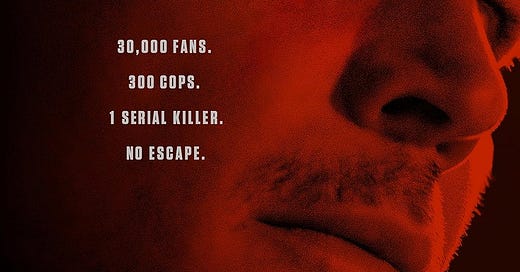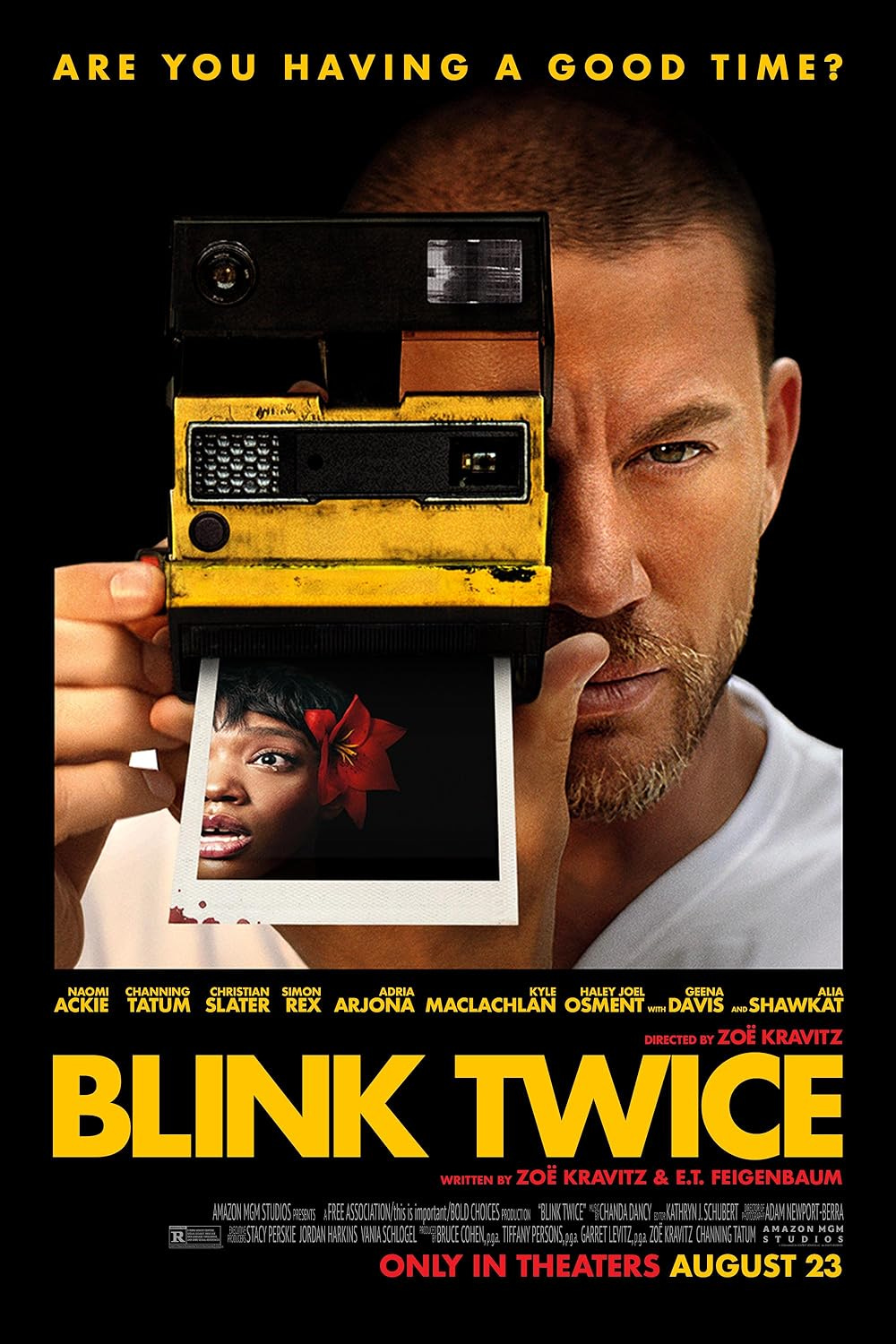Film Review: "Trap," "Blink Twice" and the Ongoing Triumph of Vibes-Based Thriller Cinema
Two new thriller films demonstrate the extent to which the genre continues to emphasize style over substance, with mostly positive results.
Hello, dear reader! Do you like what you read here at Omnivorous? Do you like reading fun but insightful takes on all things pop culture? Do you like supporting indie writers? If so, then please consider becoming a subscriber and get the newsletter delivered straight to your inbox. There are a number of paid options, but you can also sign up for free! Every little bit helps. Thanks for reading and now, on with the show!
It certainly seems as if the summer of the thriller, with both M. Night Shyamalan’s Trap and Zoë Kravitz’s Blink Twice earning at least some good reviews and a fair amount of box office. This shouldn’t surprise us too much, though, since the thriller has repeatedly proven to be a popular genre. Even though films like Saltburn, Don’t Worry Darling, and Promising Young Woman might be flawed and sometimes not particularly coherent when it comes to their stories, they still manage to exert a hold on us and, in at least one example (Saltburn) became something of a social media phenomenon. These two new films exhibit many of the same strengths and shortcomings of its predecessors.
As the trailers reveal in almost distressing detail, Trap focuses on Josh Hartnett’s Cooper, a serial killer who takes his daughter to a concert, only to discover that the whole thing is really a setup to ensnare him. The film follows his efforts to escape from the snare, which prove to be only partially successful and, in the process, we get to know a bit more about what makes him tick, though he remains something of an enigma until the very end. Blink Twice, on the other hand, follows hospitality worker Frida (a gorgeous and absolutely compelling Naomi Ackie) who gets invited to the opulent island of tech billionaire Slater King (Channing Tatum), where things take a dark and terrifying turn. She soon forges an alliance with former reality star Sarah (Adria Arjona), and the two become the badass heroines they deserve to be.
Now, I have to say at the outset that both of these films rely a great deal on a certain willing suspension of disbelief in the audience. This is particularly true with Trap, which features a premise that on paper might seem cool but that quickly starts to feel more than a little strained. Blink Twice, likewise, has a twist that anyone could see coming a mile away but which is remarkably effective at first blush, until you take more than a few minutes to think about the mechanics of it (Slater King’s motivations and explanations are just as strained). While I realize that the thriller is a genre that thrives on vibes far more than narrative coherence–see also: Saltburn–I do think it would be nice if screenwriters would take a little more time to smooth out the kinks in their screenplays before committing them to screen. The fact that both films were either written or co-written by their directors is, I fear, very much a big part of the problem.
When it comes to heroines, Blink Twice definitely has the upper hand. Both Frida and Sarah have much more to do in this film than their counterparts in Trap and, not to put too fine a point on it, they’re both much better actresses than Shyamalan (this isn’t a dig, really. I mean, she is better known as a singer than an actress). It’s more than that, though. These characters actually have something to do, and the film succeeds, to the extent that it does, because both Ackie and Arjona so perfectly transition from victims to avengers.
Trap and Blink Twice are more evenly matched when it comes to the power, charisma, and menace of their male villains. Let’s start with Josh Hartnett. Those of us who came of age in the ‘90s and early ‘00s are basically familiar with him as a romantic lead, the kind of actor it was impossible not to swoon over. There’s more than a little of that here, and there’s even a superfluous shirtless scene late in the third act that’s surely designed to encourage us to continue seeing him as an object of desire, even as we’re aware of how monstrous he is. As frustrating as the script is when it comes to giving us insight into his character and his motivations, Hartnett’s chilling charisma and power to command the screen more than makes up for it. We find ourselves compelled by him and drawn into his orbit, even as we’re repulsed by his actions.
Tatum, likewise, is nothing less than extraordinary as Slater King. The actor has shown again and again that there’s more to him than just his boyish good looks and imposing physique, though he certainly puts both of those to remarkable use in this film. He ably captures the brooding and terrible darkness at the heart of King’s psyche, one that is, like Harnett’s Cooper, borne out of trauma. We can easily see why Frida would be so drawn to him, even as his dark turn in the second half of the time makes perfect sense. Tatum is the perfect person to capture both the beauty and the horror of toxic masculinity.
Both Kravitz and Shyamalan wisely recognize the power of the close-up to engender feelings of stifling intimacy and claustrophobia, and both films have style to spare. Trap, indeed, works best when it keeps us in the same confined mental and psychological space of Cooper. When, in the third act, the action switches from the crowded stadium to the outside world, the flaws in the screenplay become more and more obvious, until it all just sort of falls apart, never to be put back together.
Blink Twice, meanwhile, works better as a story than Trap, even as it also tends to rely more on style than substance. This is the type of film that works overtime to immerse us as viewers in the hedonistic and beautiful island paradise that Slater has created for both his fellow tech-bros and the women they clearly see as little more than trophies for them to exploit. As Owen Gleiberman aptly puts it, each of the close-ups tells a story, with every object and every face bearing a potent significance. Moreover, the extensive use of close-ups–as well as Chanda Dancy’s brooding score–clue us in that all is not what it seems in this little paradise, that beneath the surface there’s terror and menace.
Despite the screenplays’ shortcomings, it’s also worth noting that both of these films have things to say, or at least they think they do. Trap, I think, comes out second in this regard. There might be a point here about the way that far too many people are prone to falling under the sway of pop stars, or maybe it’s that even the most broken and destructive of men are, in fact, the result of childhood trauma and abuse. This latter message doesn’t land particularly effectively, however, precisely because the first part of the film spends so much time indulging in the cat-and-mouse of it all rather than giving us any insight into Cooper’s personality or what led him to become a serial killer known as the Butcher.
Blink Twice, meanwhile is, like Don’t Worry Darling and Promising Young Woman (and even Get Out) something of a parable, using the unsettling affect of horror to force us as viewers to confront the ways that wealthy and powerful men manage to exploit women while also forcing them to bury their trauma and pretend as if everything is alright just so men can cling on to their fragile egos and sense of entitlement. It doesn’t always succeed as much as it might like to when it comes to delivering this message–and your mileage may definitely vary when it comes to the conclusion–but I give Kravitz a lot of credit for being willing to make a movie that actually says something significant, no matter how flawed or logically inconsistent the story itself might be.
Lastly, it’s worth noting that both of these films also commit one of the cardinal sins of filmmaking: underutilizing a phenomenal actress. In Trap’s case that’s none other than Hayley Mills, who plays Dr. Josephine Grant, the criminal profiler who has orchestrated this entire effort to capture Cooper. With Blink Twice it’s Geen Davis, who portrays Stacy, Slater’s assistant and, it turns out, a willing participant and enabler of his monstrosity. While it’s always a pleasure to see both of these formidable performers on the screen, and while they both do the most that they can with such limited material, the truth is that their parts are thinly-written and never really given a chance to become anything more than cardboard cutouts.
Though both are undeniably flawed films, I found myself truly caught up–and, more importantly, invested–in both Trap and Blink Twice. This just goes to show the extent to which the thriller as a genre can still work even when it sacrifices a little (or a lot) of narrative coherence on the altar of vibes and feelings and dread (after all, it’s not as if such thriller classics as Basic Instinct really make that much sense once you get past the Sharon Stone of it all). Even if the story doesn’t make sense beyond a surface level, I’m still glad I went to see these films. If the thriller film is going to be all about vibes, then count me in.





